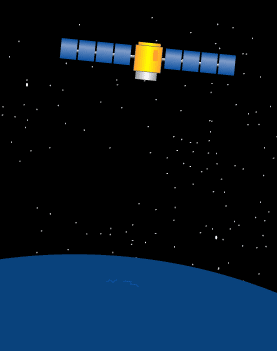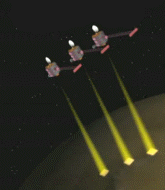 |
Artist's concept of change detection. Note that
detection occurs during periodic observations
rather than during sequential imaging.
|
The Autonomous Sciencecraft Experiment, referred to here as Sciencecraft, allows a spacecraft to choose science observations that seem interesting, to process data, and to send data back to Earth that the craft determines are scientifically important.
In early 2004, Sciencecraft was beamed onboard the New Millennium Program's in-orbit Earth Observer 1 to begin validating its "feature and change detection," "planning," and "robust execution" capabilities. Since that time, the experiment team has been conducting numerous tests of the software's autonomy capabilities. As of mid-2004, they have successfully triggered over 100 autonomously-planned image data takes and performed the first closed-loop execution where Sciencecraft autonomously analyzes science data onboard and triggers subsequent observations. See the technical paper "Using Autonomy Flight Software to Improve Science Return on Earth Observing One" for details.
Sciencecraft's image formation module transforms raw radar instrument data into synthetic aperture radar (SAR) images. The science algorithms (a procedure for solving a problem) module analyzes image data, generate science products from that data, and detect changes that have occurred since previous observations. Changes that are detected trigger new data collection. The onboard continuous planner replans activities. It also decides when to send the data back to Earth, based on science observations made during previous orbits. These capabilities:
- dramatically increase science observations with each downlink (signal that returns data) by determining the highest priority science data
- enable study of science events (volcanic eruptions and dust storms, etc.) that don't last very long
- reduce instrument inactivity due to anomalies (unexpected events) because the software includes a lot of checks of spacecraft performance
and resources to prevent errors
- reduce instrument setup time by using autonomy software that uses execution information to streamline operations
 |
|
Flying over Jupiter's moon, Io.
Click on image to view animation, with Quicktime or RealPlayer.
|
|
|
Sciencecraft technology allows missions to focus more of their resources on science events. It enables radically different missions, equipped with significant decision-making capability, to take advantage of science opportunities and return only the most interesting science data. Successful demonstration of Sciencecraft's capabilities opens up tremendous new opportunities in planetary science, space physics, and Earth science. Such opportunities aren't available without this technology.
The proven Sciencecraft software was uploaded to the Mars Exploration Rovers, Spirit and Opportunity, to assist in collecting images of Martian dust devils passing in the vicinity of the rovers.
Using Sciencecraft technology, the highly autonomous spacecraft of future NASA missions will achieve significantly greater science returns. And, they will achieve these returns with reduced risk and cost.
Jet Propulsion Laboratory is the technology provider. In addition to JPL, the team includes the University of Arizona and Arizona State University.
Download the Autonomous Sciencecraft Experiment ST6 Technology Validation Report (PDF).
View Sciencecraft technology videos. If you don't have RealPlayer, you can download the free RealPlayer (for PC-compatible
users).